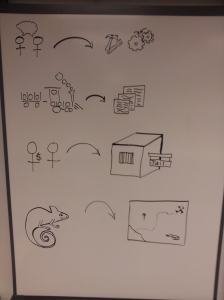So much in the Agile world centers on people and software. Ever organizing around developer iterations and quickly integrating the knowledge, feedback, and cross functional improvements. There is now a force multiplier to this effort. Not just in scaling bigger – We now are able to leverage as equally quick turns in hardware. Hardware and software are again matching in a way that allows creativity and innovation explode like never before. It used to be when we were manufacturing we would spend months in design and then more months just waiting. Spend a princely ransom in the tooling and dies needed just to do limited runs, and then get in prototypes to test how ergonomic, how appropriate for fit or rugged abuse a casing might be. Circuit boards were all or nothing propositions which rarely matched the pace of software development.
3 Dimensional Printing
3D printing has seen an explosion of the type of printers available on the market. These printers are challenging the way we thought about assembly, manufacturing, prototyping, materials, fit, cost, and the list goes on and on. From an idea to physical form is no longer taking the weeks or months it used to. Some designs can now be reality in hours. I am going to list just a few of the things that slapped me across the eyes as I got further and further into the world of hardware. As a burgeoning 3D printer owner – the game of manufacturing is about to change.
Materials
The preponderance of materials come in a filament form. Types of plastics like ABS and PLA are melted in thin layers to create models. It doesn’t stop there though. Filaflex is more like a stretchy rubber that enables the printing of more wearable items like sandals or durable phone casings. Paper, Hershey’s chocolate or sugar, metal powder melted with lasers, resins, carbon fiber and special concrete mixes are just the beginning of an exhaustive list.
Machines
Local motors unveiled the first 3D printed car with plans to be able to manufacture with a 24 hr turn around time. Microfactories allow consumers to personalize, design and customize. What does this do to inventory, supply chain and lots? New and innovative designs get noticed in a hurry.
Voxel8 looks to revolutionize circuitry. Allowing printing with traces and room for electrical components.
MakerBot is quickly adding features to every printer it creates. The community of thingiverse has grown tremendously and allows many to share designs. Not only are many playful, but categories to replace broken parts or get re-mixed with other hardware parts (Ikea is popular). Many models get remixed as evolutionary design improvements from others.
The Mcore IRIS printer makes 3D models full of life-like color. Paper-based model construction also makes the consumable materials cheaper.
Formlabs printer uses a laser hardened resin and produces some of the most finely detailed models.
Look at up and coming machine designs:
The Griffin Delta printer is defining a new standard in a printer that can be assembled as a home project. This printer also scales in size for the your intended use.
A 15 yr old is now designing the Orb. Using a record player like turntable, his modular approach and new modeling language aren’t the only innovations. Heating and material changes promise to speed the print times by a factor of 10.
Software
Sketchup, Tinkercad, Inkscape, Repetier, Blender, Slic3r, Cura, Skanect, Makerware. Software is enabling us to capture our ideas more quickly. The import and export, formats and fixes are really driven as the some of the most important features. Surface Tessellation Language (.stl) is a way of geometrically dividing and describing a surface. The .STL file is common but not the only way to capture 3 dimensional information. Meshes and object capture are also common. HTML5 and Fusion tables allow interaction with different types of 3 dimensional information.
Measurement is predominantly in metric as it scales so much more easily. mm and microns are common units. Software also starts being predictable at model supports, material needed and time to print. Speeds (for the moment) are mm/s. All this easily translates into predictable micro transactions of a few dollars.
If You Can See It
Hardware and software allows 3-D scanning of objects around us. ASUS Kinect is often used with a 3D printed handle to scan in art and people. A cosplay or Halloween costume becomes an action figure. Possibly even a chess piece as an aggregated 3D model of a family portrait. Makerbot’s Digitizer sells alongside their printers. Another amazing must have in this year’s laptops and phones is Intel’s RealSense. This camera will scan, measure, translate objects into models and give us that long awaited Minority Report interaction with the screen.
Remix Ideas
Take some relatively disparate areas and start enabling a 3D mindset. Letting kids use a Sharpie for drawing can easily translate into a 3D toy. Video Games already hold 3D models. Popular pokemon figures, Minecraft buildings can all be exported and create a personal model to inspire and spark the imagination. NASA topographical data and even Google Earth buildings can be used for sections of landscape or cityscape models.
I am very much looking forward to the innovative “WOW” factor as 3d printing continues to affect so many products, so quickly. Personal in a visual and tactile way; ideas are more agile than ever.
 t much, much better.
t much, much better.